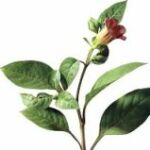
Legend has it that belladonna, which means “beautiful woman” sometimes takes the form of a stunningly gorgeous enchantress who is dangerous to behold. Or belladonna may be so-named because Italian ladies once used the juice to dilate their pupils, making their eyes more brilliant. Belladonna is a source of atropine, which is used to treat eye diseases and spasms.
Tall perennial with erect, branched stems, and pointed, ovate leaves, up to 20cm (8in) long. Purple-brown, bell-shaped flowers, about 2.5cm (1in) across, appear during summer, followed by shiny, black berries, 1-2cm (½-¾in) across, with a persistent calyx.
Has yellow-green flowers. |
|||||||||||||||||||||||||||||||||||||||||||||||||||||||||||||||||||||||||||||||||||||||||||
To treat spasms and pain in the gastrointestinal tract; to treat gout, meningitis, and tonsilitis, and inflammation of the skin, joints, or gastrointestinal tract. Belladonna root is used to treat irregular heartbeat, pain in the gastrointestinal tract and bile duct, asthma, and bronchitis. Germany’s Commission E has approved the use of belladonna leaf and root to treat gallbladder and liver complaints. |
|||||||||||||||||||||||||||||||||||||||||||||||||||||||||||||||||||||||||||||||||||||||||||
This herb and its alkaloids are subject to legal restrictions in some countries. |
|||||||||||||||||||||||||||||||||||||||||||||||||||||||||||||||||||||||||||||||||||||||||||
|
|||||||||||||||||||||||||||||||||||||||||||||||||||||||||||||||||||||||||||||||||||||||||||
The Essential Herb-Drug-Vitamin Interaction Guide by Geo. T. Grossberg,MD and Barry Fox,PhD. Copyright©2007 Barry Fox,PhD. pp.60-62 |
|||||||||||||||||||||||||||||||||||||||||||||||||||||||||||||||||||||||||||||||||||||||||||


